Email Drip Campaigns 101: Everything You Need to Know
It seems like the term “drip emails” keeps popping up all over the place. If you open the features section of nearly any digital marketing tool, it is there. If you explore educational content about email marketing, it is there too.
But what is really happening? Is it yet another buzzword or something useful?
Short answer – Drip emails are quite practical. In this article, we have compiled a guide to help you get the most out of them.
What Is an Email Drip Campaign?
An email drip campaign is a series of pre-made email messages that your email marketing tool can automatically send out to your audience. Your new subscribers or users see these “drips” of information based on a predefined timeline or set of triggers that activate when they perform specific actions.
Digital marketers strategically set these timings and triggers within the journey your users are going through with your website or product. Thanks to sending emails at the right time, they are able to maximize their return on investment (ROI) and the output of their email marketing efforts.
Imagine you have an online shoe store. As soon as a customer signs up on your website, your goal is to start engaging them with your store and products.
So, you can set up a drip campaign that will send your users a “welcome” as soon as they sign up–creating a warm and friendly tone of conversation between your brand and them.
Up next, you can create a combination of user activity and time triggers to “ping them” if they are not engaged with your website. The trigger rule will look something like this:
Send an email when the user has not visited my website for more than 7 days.
The message itself can be a showcase of your best products (to attract their interest in exploring your shop) or even a special discount offer (to get them to buy a product).
Now, while drip campaigns have many benefits, the greatest reason to use them is that they can make your messages more relevant to your customers.
You are able to send emails to your users at a moment it is relevant to them (e.g. give them a discount when they abandon the cart), and with relevant content (e.g. suggest ski masks after they buy skis).
Thanks to this relevance, you will be able to:
- Get higher ROI on your campaigns as drip campaigns are able to get you 80% higher sales revenue than ordinary marketing emails
- Avoid frustrating your users with irrelevant messages that will both hurt your brand reputation and get you in the spam list of their email provider
- Save the time of your marketing team, as these are automated emails and your team needs to set it up only once
So, to sum up, an email drip campaign is an excellent tool in the hands of your digital marketers; they get the most out of their efforts and in return, your customers remain happy with timely and relevant messages.
Now, let’s dig a bit deeper into the topic of email drip campaigns by looking at some of the most common use cases of this tool and discussing real-world case studies for each of them.
How Do Drip Campaigns Fit Into Your Marketing and Sales Funnel?
Usually, drip campaigns will not live in isolation from the rest of your marketing activities. Instead, you will integrate them into existing funnels that your marketing and sales teams have made in order to give these funnels a bit of a boost.
Technically, you can also isolate a drip campaign from funnels. However, I would not advise this, since a funnel without a drip campaign is less effective. Remember the 80% sales boost I just mentioned?
This works the other way around too. A drip campaign without a funnel will suffer from relevance as you don’t have the right high-intent people signing up and using your product which is something that well-built funnels provide.
Combining funnels with drip campaigns results in these two complementing each other and producing better results.
Let’s look at a couple of types of drip campaigns that you can use as part of your funnel.
Nurturing leads
Let’s begin at the earlier steps in the funnel where drip campaigns can help you nurture your leads and increase the chances of them signing up or trying out your products or services.
In this case, use time-bound triggers to send your drip campaign emails (e.g., a couple of days after they sign up for your newsletter).
Some of the common types of messages that you send for this use case include:
- Educational materials about your products (a beloved tactic among SaaS content marketing agencies)
- Offers of free trials or discounts to get your subscribers to use your products
- An FAQ that answers some of the potential concerns your users have.
- Improving your brand awareness and trust by sharing testimonials, reviews, and other types of social proof
There’s also the good old “showcase your product” type of email like the one we have below:
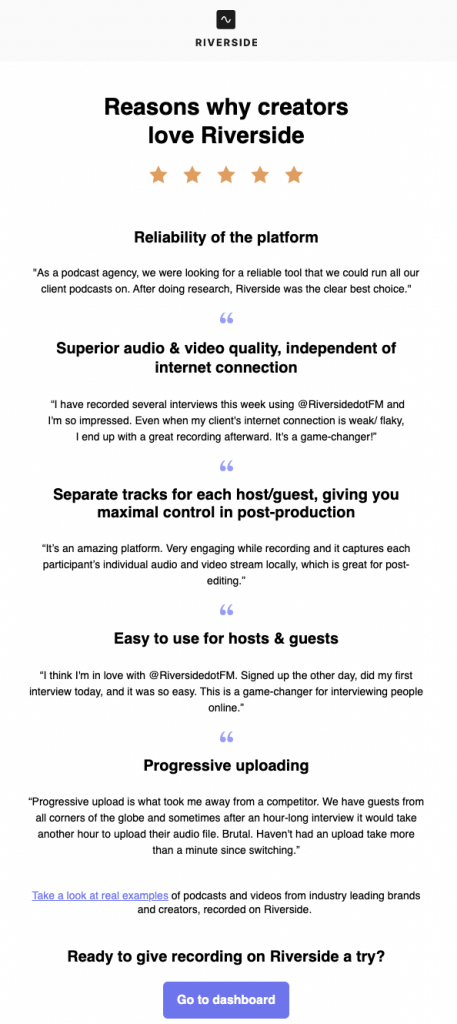
Riverside.fm is an audio and video podcasting service that helps creators edit and publish their podcasts.
In this email, which was sent to their prospects, they showcase some of the key features of their product, including audio quality, separate tracks for hosts, etc.
Welcoming
If you have sparked the interest of your potential users in your product and they decide to sign up, then you can set up a drip campaign to help you with another crucial step–user activation.
Activation is the process of new users navigating through your product and reaching the point where they experience the value that it offers.
A great way to aid activation is by sending a “welcome” onboarding email. Here is an example.
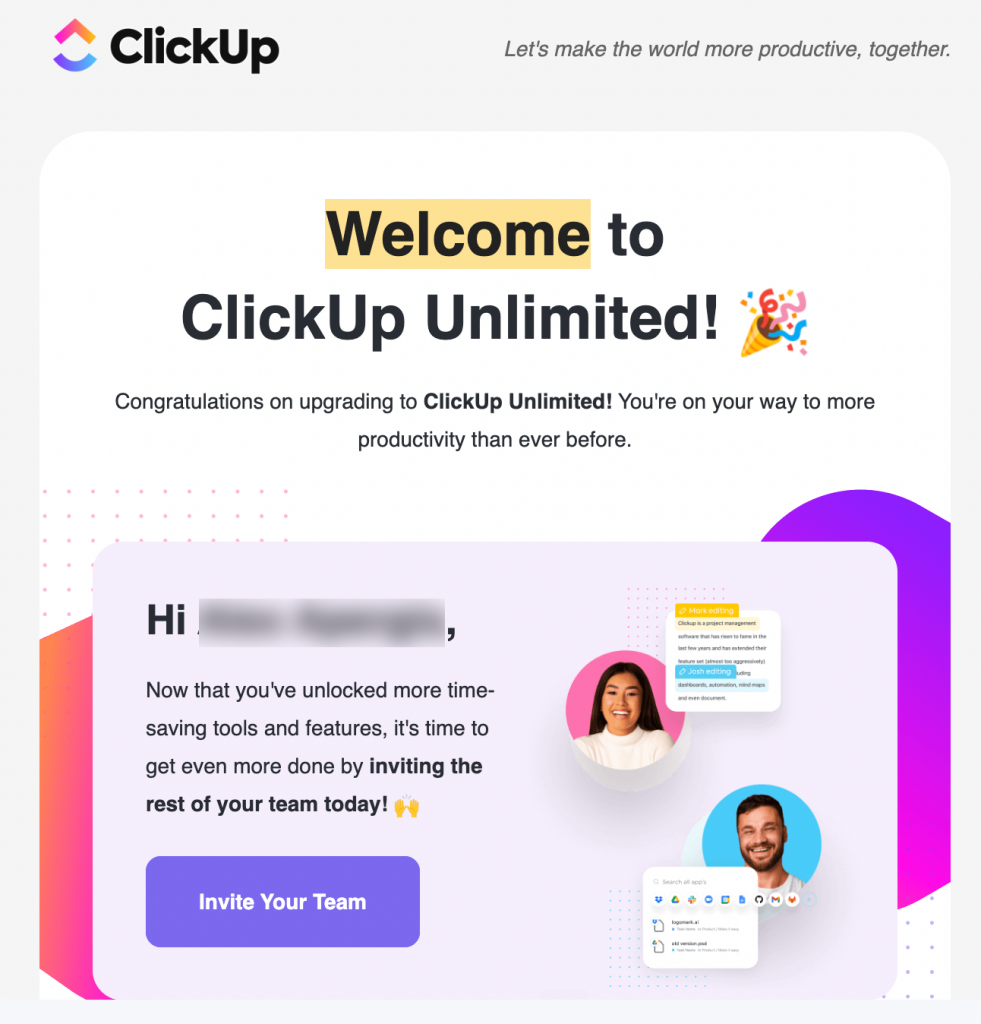
ClickUp is an all-in-one productivity and project management platform that comes with task tracking, a wiki, CRM, and more.
In the first email they send to new Unlimited users, they prompt you to invite your teammates into your new ClickUp instance with a direct call-to-action (CTA).
They do this since you can’t really experience the benefits of this product if you’re alone, so you will need your team to create documents, and tasks, and collaborate on them in order to experience the key value that ClickUp offers.
Confirmations
Now, imagine that you have successfully nurtured, brought in, and converted a prospect into a paying customer. Is your job done?
Not really. The best customers are the ones who stay with you and use your product continuously. Therefore, you will need to continue engaging them and running nurturing campaigns after each of their purchases.
This is where a purchase confirmation email comes into play. Let’s look at one from a well-known hospitality service Booking.com.
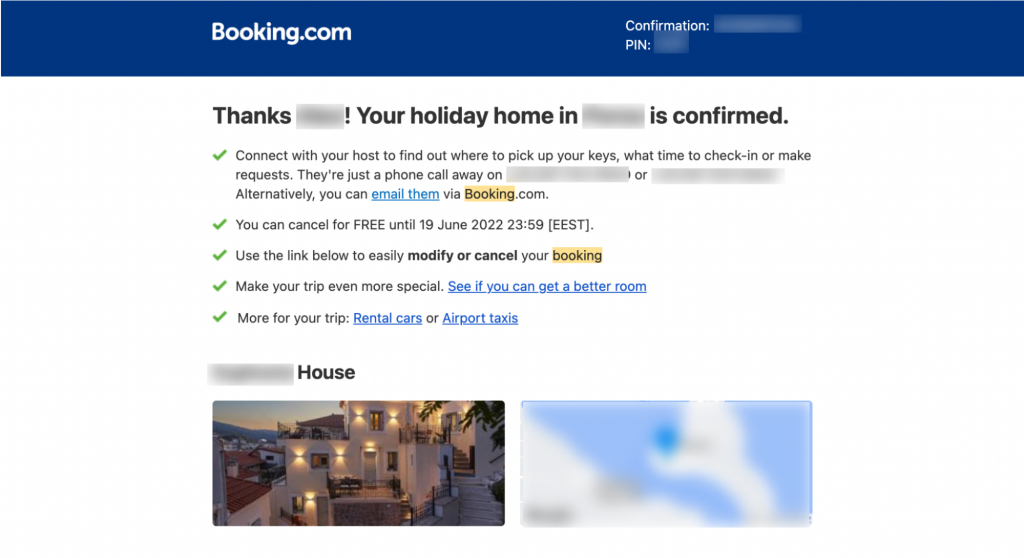
As soon as you have finalized your booking, the service will send you a confirmation email that they use to:
- Let you know that the transaction was a success and your booking is active
- Give you guidance on how to find your stay when you arrive at your destination and other similar tips
- Tell you how you can modify or cancel your booking
- Offer upselling (get a better room) and cross-selling (rent a car or an airport taxi) opportunities
With this message, Booking.com creates a positive customer experience by giving tips and guidance to their users, while attempting to increase sales revenue by upselling and cross-selling services.
Engagement
Let’s look at another interesting use case where a drip email sequence comes into play–assisting with engagement through activation.
Activation is the journey of your users from the point they have signed up for your new product to the point that they have reached their “AHA moment”.
It represents the moment when your users realize the value of your product while they are interacting with its key features and capabilities. Take Spotify for instance. The AHA moment for them is when the user finds a song and starts streaming it.
Activation is a critical part of your customer journey and improving it will result in more people experiencing the AHA moment, which, in turn, will lead to better engagement.
Unfortunately, you will end up losing lots of people throughout the activation phase. But the good news is that they are relatively easy to “resurrect” by using various techniques, including drip emails.
Let’s look at a real-life example of such an email.
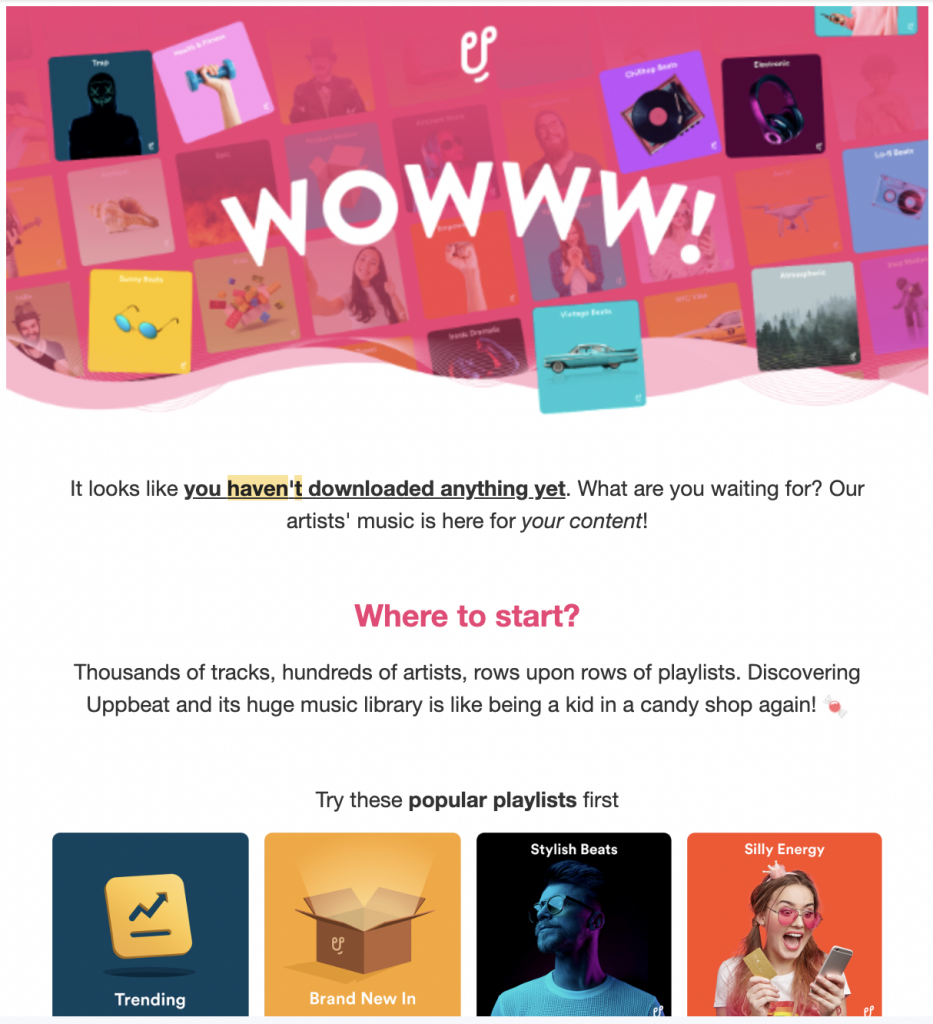
Uppbeat is a music service that provides YouTubers and other types of media content creators with license-free music that they can use in their works.
If you sign up for this service but don’t download anything, they will send you a drip email prompting you to get back to their app and download your first song (their AHA moment).
Moreover, they will suggest some of the most popular playlists as a way of sparking your interest in exploring and downloading a song from them.
Cart abandonment
Finally, let me talk a little bit about a use case for drip emails that digital marketers love using for eCommerce businesses – retargeting abandoned shopping carts.
This is the type of email sent to those users who have added items to their cart and have either forgotten to check out or decided against the purchase.
A cart abandonment follow-up email will usually go out after a couple of days or a week of the incomplete checkout and include incentives such as free shipping or extra discounts for the user to come back and make the purchase.
The reason behind email marketers liking this type of drip message is their great performance (45% open rate) and the fact that you can increase sales revenue by re-engagement of your users.
Let me show you an example of this with eCommerce giant Wish.com.
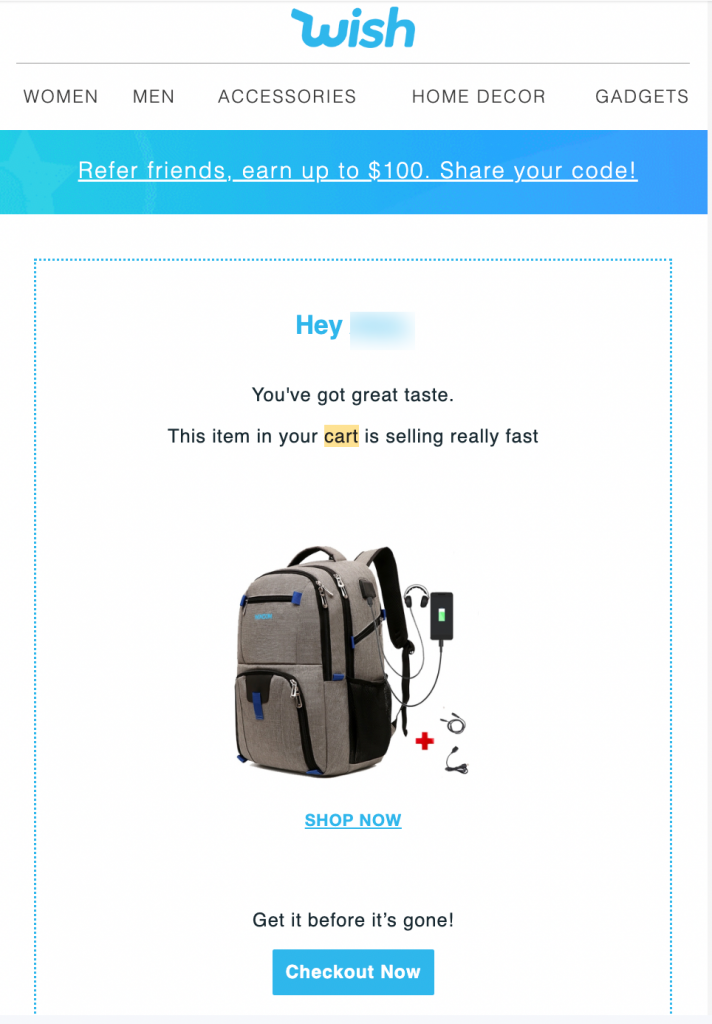
In this particular abandoned cart email, Wish.com has not given us extra discounts or free shipping. Instead, they are using the good old fear-of-missing-out (FOMO) technique to let you know that if you don’t check out now, the item may go out of stock soon.
To sum up, drip emails are useful tools for you in nearly all spots in your sales and marketing funnel–letting you get better lead nurturing, activations, and customer engagement.
Now that we have explored the ways you can use drip email in real life, let us help you with the process of setting up and running drip marketing campaigns.
How to Set Up an Email Drip Campaign Step-by-Step
Just like any kind of email marketing activity, your email drip campaigns will need to follow the well-known research-launch-measure process. For drip campaigns in particular, I recommend breaking down this process into five steps and following them one-by-one.
Step #1: Identify your audience and set triggers
We begin the setup of the drip sequence with research. In particular, you want to learn more about the people that your messages will be targeting.
The type of information that you can gather to better understand the people in your email list includes:
- Demographic data: Age, gender, geography, and more
- Behavioral data: Past purchase data, engagement rate, etc
- Interests: The type of products and services that they prefer
After gathering all this information, you can decide how to set your triggers (e.g. the time of sending the email will depend on the time zone of your users).
Step #2: Set objectives
The second step is to understand what you want to achieve from your drip campaigns. Your objective will influence both the type of content you send and the triggers/timing of the drip message.
Typical objectives include activating users, engaging them, trying to cross/upsell, and others.
If, for instance, you have an objective of cross-selling, then the best time to send a message is after the purchase is complete, and the best content is relevant suggestions of related products.
Step #3: Craft content
Once you know why you are making your drip campaigns and who they are targeting, you can go ahead with creating the content itself.
Here, you will need to show off two important skills of yours – email copywriting, and visual content creation (or you can ask a designer to help with this one).
Step #4: Launch campaign
After crafting a compelling message, you can go ahead and run the campaign.
Drip email marketing is a key feature in many modern email marketing software such as MailChimp, and HubSpot. You can use their marketing automation tool and the workflow feature (including campaign templates and pre-made series of emails) to set your triggers based on timing/delay and user actions.
A quick tip here is to keep your email list clean to avoid bounces and unsubscribes.
Step #5: Track performance
We have reached the “measure” phase of the process. As soon as you have launched your campaign, your marketing tool will show you analytical data on some of the most important metrics, such as:
- Open rate
- Click-through rate
- Conversion rate
- Deliverability, and more.
The good news is that the process I have described is already baked into modern email automation tools and autoresponders, so you can take advantage of their user-friendly interface to easily do your research, craft emails, launch, do A/B testing, and measure them.
Now, as a bonus, let me share a couple of handy tips with you to take your drip campaigns to the next level.
3 Tips to Keep in Mind When Creating an Email Drip Campaign
Although they are the automated and smart counterparts to your regular email marketing campaigns, they are still ordinary emails in the eyes of your recipients. Therefore, you should treat the content of these messages the same way you do your regular emails.
In particular, I suggest you focus on the following three aspects.
Tip #1: Personalize emails
Personalization is usually the first thing that I advise email marketers to consider for improving their messages. There is a good reason that personalization has become one of the key trends in the world of digital marketing in recent years–it performs very well.
In fact, sending personalized emails can result in an 82% boost in your email open rates compared to ordinary messages.
Some common ways to personalize emails include tweaking content and subject lines and including the recipient’s name, city, preferences, and past purchases (in the case of online shops).
Tip #2: Offer value
Even if you create an email with compelling copy and stunning visuals, people will not care about it unless they find something in it valuable and relevant to them.
After all, the main question that people will ask when they read your email is “What’s in it for me?”. Therefore, you need to clearly indicate the value that you offer them.
In cart abandonment emails, for instance, the value is the extra discount that you are giving to your users.
Another pro tip here is to make sure that you are reaching out to the right people with your pitch. For instance, you should find the email and contact the CTO if you want to offer hosting services.
Tip #3: Focus on relationship building
Don’t forget that email marketing (including drip campaigns) is not a one-time affair; you will need to focus on long-term interaction with your new customers.
To make sure that your messages are helping with building customer relationship, you can do the following:
- Keep the conversation tone friendly to establish a sense of trust and comfort in your readers.
- Send welcome emails to your potential customers and thank existing customers for being with you.
- Remember the birthdays of your loyal customers and send them a gift (e.g. a discount coupon).
Although you will not see any immediate results in your key email metrics by following this tip, your overall performance will start improving in the long run.
Finally, make sure that your branding (colors, logo, etc.) is visible and prominent in your messages to help users easily associate your messages with your company.
Now over to You
Email drip campaigns are great tools in the hands of both experienced and novice digital marketers and are an essential part of their marketing strategy.
They are able to reach your target audience at the right time with the right message while taking little time for you to set them up and maintain them.
But drip campaigns are only a single element of the larger discipline of email marketing. If you want to explore this topic further, check out our blog.

Sona Kalantaryan is a senior digital marketer with a creative past. Big fan of high cinema and well-optimized landing pages. She authors guides by sharing the best practices and does it the right way!
